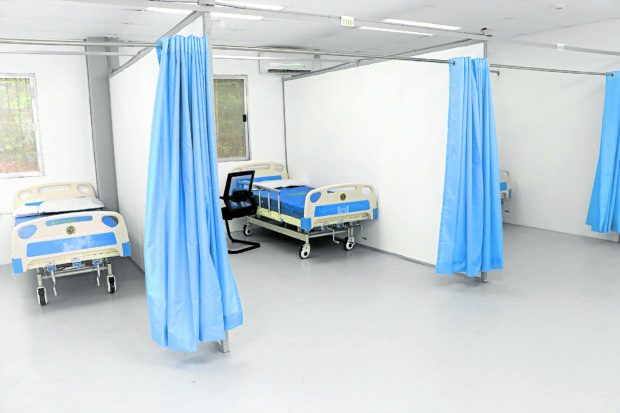More COVID-19 beds available in Subic

ALTERNATIVE SITE The newly opened 500-bed isolation facility in Subic Bay Freeport will accept COVID-19 patients from Metro Manila as hospitals in the country’s capital reach capacity. —PHOTO COURTESY OF SUBIC BAY METROPOLITAN AUTHORITY
SUBIC BAY FREEPORT, Philippines — The government on Wednesday opened a temporary treatment and monitoring facility in this free port that would accept COVID-19 patients who could not be accommodated in hospitals in Metro Manila.
The 500-bed center at the 11.4-hectare former Cubi Hospital complex was developed as the occupancy rate in government quarantines “rose dangerously,” said Vivencio Dizon, deputy chief implementer of the National Task Force Against COVID-19 and the official overseeing the government’s coronavirus testing.
Dizon, along with Health Undersecretary Leopoldo Vega, led the center’s opening at the Manila Times College Inc. compound.
According to Dizon, the facility can accommodate COVID-19 patients who have no symptoms or those who will show mild symptoms, allowing hospitals in Metro Manila to attend to those with moderate to severe symptoms. This free port is some 138 kilometers from the national capital.
At least four buildings in the area, including a dormitory, have been converted into isolation wards that officials described as “structurally sound” and which have power and water supplies.
Article continues after this advertisement“We have to improve our infrastructure on health. Health infrastructure means it must be very responsive to the needs of the community, especially during a pandemic,” said Vega, the health official tasked to oversee the treatment of COVID-19 patients, during the center’s opening.
Article continues after this advertisementFears
Last month, residents and business operators in the free port expressed their fears that the operation of the facility might expose more locals and workers to the virus.
But Wilma Eisma, chair and administrator of the Subic Bay Metropolitan Authority, defended the project.
“The number one assurance we can give them is this location, which is so far away from everybody else,” Eisma said in a statement.
She said the remote location of the facility, as well as strict health protocols observed in Subic, would ensure the safety of everyone.
According to Eisma, the facility is in a fenced and gated compound, noting that it is virtually a “self-contained community.”
“I am sure that the Office of the Civil Defense will take all the necessary steps to make sure that everybody who will be working here and will be confined here will be limited to the compound,” Eisma said.
She added: “And if there is a need to go out, they will be properly guarded, properly monitored.”
According to Eisma, the free port has one of the lowest numbers of COVID-19 cases in the country due to its strict adherence to protocols. The economic zone also hosts a COVID-19 referral hospital, isolation facilities, and swabbing and testing centers.
“With what we have learned from the past and what we continue to learn, I can guarantee the community of Subic that we will do everything to make sure that not only is this place contained, but that this place will also service the needs of the community when the need arises,” she said.
Isolation in rehab center
In Nueva Ecija province, the Drug Abuse Treatment and Rehabilitation Center (DATRC), a Chinese-donated facility for drug dependents inside the Army’s Fort Magsaysay, has some 400 beds dedicated to COVID-19 patients.
But Dr. Nelson Dancel, the DATRC medical chief, said the Temporary Treatment and Monitoring Facility (TTMF) at the center is being run by the Bureau of Quarantine.
“This facility was designated exclusively for COVID-19 patients,” Dancel told the Inquirer in a phone interview on Wednesday, referring to the area where returning overseas Filipinos were quarantined last year.
The TTMF is attending to at least 90 patients, including soldiers, he said.
While the DATRC is under the Department of Health (DOH), the TTMF has a separate staff, Dancel said.
But he said the DOH regional office in Central Luzon could recommend patients for confinement in the TTMF.